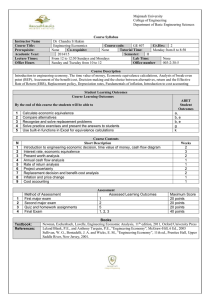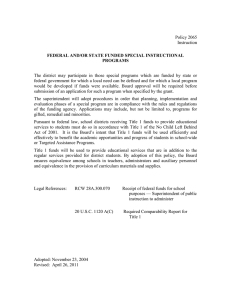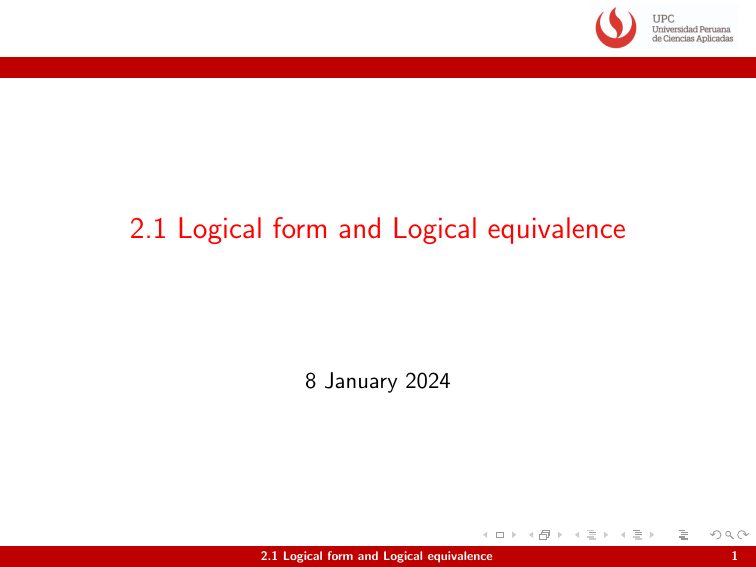
2.1 Logical form and Logical equivalence 8 January 2024 2.1 Logical form and Logical equivalence 1 Content Statements: definition and composing new statements and, or, negation 1 Statements: definition and composing new statements and, or, negation 2 Truth values and truth table 3 Tautologies and contradictions 4 Logical equivalence and nonequivalence 5 De Morgan’s law 2.1 Logical form and Logical equivalence 2 Statements: definition and compound statements Statements: definition and composing new statements and, or, negation In logic, the words sentence, true, false are the initial undefined terms. Definition A statement (or proposition) is a sentence that is true or false but not both. Example Indicate which of the following sentences are statements. (a) 1024 is the smallest four-digit number that is a perfect square. (b) She is a mathematics major. (c) 128 = 26 (d) x = 26 2.1 Logical form and Logical equivalence 3 Statements Statements: definition and composing new statements and, or, negation Example Answers: (a) It is a statement because it is a true sentence. 1024 is a perfect square because 1024 = 322 , and the next smaller perfect square is 312 = 961, which has less than four digits. (b) It is not a statement since the truth or falsity of this sentence depends on the reference for the pronoun she. (c) It is a statement because it is false. 26 = 64. (d) It is not a statement because the truth or falsity depends on the value of x: for x = 64 it is true, but for other values of x it is false. 2.1 Logical form and Logical equivalence 4 Compound statements Statements: definition and composing new statements and, or, negation Symbols that are used to build logical expressions out of simpler ones: (i) the symbol ∼ denotes not. Given a statement p, the sentence ∼ p is read not p or It is not the case that p. ∼ p is called the negation of p. (ii) the symbol ∧ denotes and. Given statements p, q, the sentence p ∧ q is read p and q and is called the conjunction of p and q. (iii) the symbol ∨ denotes or . Given statements p, q, the sentence p ∨q is read p or q and is called the disjunction of p and q. 2.1 Logical form and Logical equivalence 5 Compound statements Statements: definition and composing new statements and, or, negation The order of operations and rules: (i) ∼ is performed first. Example: ∼ p ∧ q = (∼ p) ∧ q. (ii) for ∧ and ∨ we use parantheses. Example: an expression p ∧ q ∨ r is ambiguous. It must be written as either (p ∧ q) ∨ r or p ∧ (q ∨ r ). (iii) ”p but q” means (iv) ”neither p nor q” ∼ p∧ ∼ q. ”p and q”. Symbolically, p ∧ q. means ”not p and not q”. Symbolically, 2.1 Logical form and Logical equivalence 6 Compound statements: Example 1 Statements: definition and composing new statements and, or, negation Let s=stocks are increasing and i=interest rates are steady. Write the following statements in symbolic form. (a) Stocks are increasing but interest rates are steady. (b) Neither are stocks increasing nor are interest rates steady. 2.1 Logical form and Logical equivalence 7 Compound statements: Example 1 Statements: definition and composing new statements and, or, negation Let s=stocks are increasing and i=interest rates are steady. (a) s ∧ i (b) ∼ s ∧ ∼ i 2.1 Logical form and Logical equivalence 8 Compound statements: Example 2 Statements: definition and composing new statements and, or, negation Let h=John is healthy, w =John is wealthy and s=John is wise. Write the following statements in symbolic form. (a) John is healthy and wealthy but not wise. (b) John is neither wealthy nor wise, but he is healthy. 2.1 Logical form and Logical equivalence 9 Compound statements: Example 2 Statements: definition and composing new statements and, or, negation Let h=John is healthy, w =John is wealthy and s=John is wise. Write the following statements in symbolic form. (a) (h ∧ w )∧ ∼ s (b) (∼ w ∧ ∼ s) ∧ h 2.1 Logical form and Logical equivalence 10 Compound statements: Example 3 Statements: definition and composing new statements and, or, negation Assume x is a particular real number. Introduce statements and write inequalities in symbolic form. (a) −2 < x < 7 (b) x < 2 or x > 5 (c) 1 > x ≥ −3 2.1 Logical form and Logical equivalence 11 Compound statements: Example 3 Statements: definition and composing new statements and, or, negation Assume x is a particular real number. Introduce statements and write inequalities in symbolic form. (a) Let p be x > −2 and q be x < 7. Then p ∧ q. (b) Let p be x < 2 and q be x > 5. Then p ∨ q. (c) Let p be x > −3, q be x = −3 and r be x < 1. Then (p ∨ q) ∧ r . 2.1 Logical form and Logical equivalence 12 Content Truth values and truth table 1 Statements: definition and composing new statements and, or, negation 2 Truth values and truth table 3 Tautologies and contradictions 4 Logical equivalence and nonequivalence 5 De Morgan’s law 2.1 Logical form and Logical equivalence 13 Truth values. Statement forms Truth values and truth table Compound sentences are made of components statements and the terms and, or and not. If such sentences are to be statements, then they must have well-defined truth values. Every statement has a truth value, namely true (denoted by T ) or false (denoted by F ). We now define such compound sentences as statements by specifying their truth values in terms of the statements that compose them. The truth values comprise a truth table for the statement. Definition A statement form (or propositional form) is an expression made up of statement variables (such as p, q, r ) and logical connectives (∧, ∨, ∼). It becomes a statement when actual statements are substituted for the component statement variables. The truth table for a given statement form displays the truth values that correspond to all possible combinations of truth values for its component statement variables. 2.1 Logical form and Logical equivalence 14 Truth table for negation of a statement Truth values and truth table Let p be a statement variable. Construct a truth table for ∼ p. 2.1 Logical form and Logical equivalence 15 Truth table for negation of a statement Truth values and truth table Let p be a statement variable. Construct a truth table for ∼ p. p T F ∼p F T 2.1 Logical form and Logical equivalence 16 Truth table for conjunction of two statements Truth values and truth table Let p and q be statement variables. Construct a truth table for p ∧ q. 2.1 Logical form and Logical equivalence 17 Truth table for conjunction of two statements Truth values and truth table Let p and q be statement variables. Construct a truth table for p ∧ q. p T T F F q T F T F p∧ q T F F F 2.1 Logical form and Logical equivalence 18 Truth table for disjunction of two statements Truth values and truth table Let p and q be statement variables. Construct a truth table for p ∨ q. 2.1 Logical form and Logical equivalence 19 Truth table for disjunction of two statements Truth values and truth table Let p and q be statement variables. Construct a truth table for p ∨ q. p T T F F q T F T F p∨ q T T T F 2.1 Logical form and Logical equivalence 20 Truth table: Example 1 Truth values and truth table Let p and q be statement variables. Construct a truth table for ∼ p ∧ q. 2.1 Logical form and Logical equivalence 21 Truth table: Example 1 Truth values and truth table Let p and q be statement variables. Construct a truth table for ∼ p ∧ q. p T T F F q T F T F ∼p F F T T ∼p∧q F F T F 2.1 Logical form and Logical equivalence 22 Truth table: Example 2 Truth values and truth table Let p and q be statement variables. 1. Write the statement form p or q but not both symbolically. 2. Construct a truth table for the statement p or q but not both. 2.1 Logical form and Logical equivalence 23 Truth table: Example 2 - Solution Truth values and truth table Let p and q be statement variables. 1. Write the statement form p or q but not both symbolically. 2. Construct a truth table for the statement p or q but not both. 1. Symbolically (p ∨ q)∧ ∼ (p ∧ q). p T T F F q T F T F p∨q T T T F p∧q T F F F ∼ (p ∧ q) F T T T (p ∨ q)∧ ∼ (p ∧ q) F T T F 2.1 Logical form and Logical equivalence 24 Content Tautologies and contradictions 1 Statements: definition and composing new statements and, or, negation 2 Truth values and truth table 3 Tautologies and contradictions 4 Logical equivalence and nonequivalence 5 De Morgan’s law 2.1 Logical form and Logical equivalence 25 Tautologies and Contradictions Tautologies and contradictions Definition A tautology is a statement form that is always true regardsless of the truth values of the individual statements substituted for its statement variables. A statement whose form is a tautology is a tautological statement, denoted by t. A contradiction is a statement form that is always false regardless of the truth values of the individual statements substituted for its statement variables. A statement whose form is a contradiction is a contradictory statement, denoted by c. Hence the truth of a tautological statement and the falsity of a contradictory statement are due to the logical structure of the statements themselves and are independent of the meanings of the statements. 2.1 Logical form and Logical equivalence 26 Tautologies and contradictions: Example 1 Tautologies and contradictions Show that the statement form p∨ ∼ p is a tautology and that the statement form p∧ ∼ p is a contradiction. 2.1 Logical form and Logical equivalence 27 Tautologies and contradictions: Solution 1 Tautologies and contradictions Construct a truth table for p∨ ∼ p and p∧ ∼ p. p T F ∼p F T p∨ ∼ p T T p∧ ∼ p F F 2.1 Logical form and Logical equivalence 28 Tautologies and contradictions: Example 2 Tautologies and contradictions Use truth table to establish whether a statement form (p∧ ∼ q) ∧ (∼ p ∨ q) is tautology or contradiction. 2.1 Logical form and Logical equivalence 29 Tautologies and contradictions: Solution 2 Tautologies and contradictions p T T F F q T F T F ∼p F F T T ∼q F T F T p∧ ∼ q F T F F ∼p∨q T F T T (p∧ ∼ q) ∧ (∼ p ∨ q) F F F F Truth values of (p∧ ∼ q) ∧ (∼ p ∨ q) are all F, so it is a contradiction. 2.1 Logical form and Logical equivalence 30 Content Logical equivalence and nonequivalence 1 Statements: definition and composing new statements and, or, negation 2 Truth values and truth table 3 Tautologies and contradictions 4 Logical equivalence and nonequivalence 5 De Morgan’s law 2.1 Logical form and Logical equivalence 31 Logical equivalence and nonequivalence Logical equivalence and nonequivalence Definition Two statement forms are called logically equivalent if, and only if, they have identical truth values for each possible substitution of statements for their statement variables. The logical equivalence of statement forms P and Q is denoted by P ≡ Q. Two statements are called logically equivalent if, and only if, they have logically equivalent forms when identical component statement variables are used to replace identical component statements. 2.1 Logical form and Logical equivalence 32 How to show logical equivalence of two statement forms? Logical equivalence and nonequivalence Let P and Q be two statement forms. To test for logical equivalence: 1. Construct a truth table with one column for the truth values of P and another column for the truth values of Q. 2. Check each combination of truth values of the statement variables to see whether the truth value of P is the same as the truth value of Q. (a) If in each row the truth value of P is the same as the truth value of Q, then P and Q are logically equivalent. (b) If in some row P has a different truth value from Q, then P and Q are not logically equivalent. 2.1 Logical form and Logical equivalence 33 Logical equivalence: Example 1 Logical equivalence and nonequivalence Construct a truth table to show that the negation of the negation of a statement is logically equivalent to the statement, annotating the table with a sentence of explanation. 2.1 Logical form and Logical equivalence 34 Logical equivalence: Example 1 - Solution Logical equivalence and nonequivalence Let p be a statement. Need to show ∼ (∼ p) ≡ p. Construct a truth table for ∼ (∼ p). p T F ∼p F T ∼ (∼ p) T F p and ∼ (∼ p) always have the same truth values, so they are logically equivalent. 2.1 Logical form and Logical equivalence 35 Logical equivalence: Example 2 Logical equivalence and nonequivalence Determine whether the following statement forms are logically equivalent. In each case, construct a truth table and include a sentence justifying your answer. (a) p ∨ t and t, where t is a tautology. (b) p ∨ (p ∧ q) and p. 2.1 Logical form and Logical equivalence 36 Logical equivalence: Example 2 (a) - Solution Logical equivalence and nonequivalence Let us construct a truth table. p T F t T T p∨t T T p∨t and t always have the same truth values, so they are logically equivalent., i.e. p∨t≡t. 2.1 Logical form and Logical equivalence 37 Logical equivalence: Example 2 (b) - Solution Logical equivalence and nonequivalence Let us construct a truth table. p T T F F q T F T F p∧q T F F F p∨(p∧q) T T F F p T T F F p∨(p∧q) and p always have the same truth values, so they are logically equivalent., i.e. p∨(p∧q)≡p. 2.1 Logical form and Logical equivalence 38 Content De Morgan’s law 1 Statements: definition and composing new statements and, or, negation 2 Truth values and truth table 3 Tautologies and contradictions 4 Logical equivalence and nonequivalence 5 De Morgan’s law 2.1 Logical form and Logical equivalence 39 Logical equivalence De Morgan’s law Show logical equivalence of the statement forms: (a) ∼ (p ∧ q) ≡∼ p∨ ∼ q (HW) (b) ∼ (p ∨ q) ≡∼ p∧ ∼ q 2.1 Logical form and Logical equivalence 40 Logical equivalence: Solution to (b) De Morgan’s law Let us construct a truth table. p T T F F q T F T F ∼p F F T T ∼q F T F T p∨q T T T F ∼(p∨q) F F F T ∼ p∧ ∼ q F F F T ∼ (p ∨ q) and ∼ p∧ ∼ q always have the same truth values, so they are logically equivalent., i.e. ∼ (p ∨ q) ≡∼ p∧ ∼ q 2.1 Logical form and Logical equivalence 41 De Morgan’s laws De Morgan’s law (i) The negation of an and statement is logically equivalent to the or statement in which each component is negated. If p and q are statements, then ∼ (p ∧ q) ≡∼ p∨ ∼ q (ii) The negation of an or statement is logically equivalent to the and statement in which each component is negated. If p and q are statements, then ∼ (p ∨ q) ≡∼ p∧ ∼ q 2.1 Logical form and Logical equivalence 42 De Morgan’s laws: Example 1 De Morgan’s law Write negations for each of the following statements: (a) John is 6 feet tall and he weighs at least 200 pounds. (b) The bust was late or Tom’s watch was slow. 2.1 Logical form and Logical equivalence 43 Solution 1 De Morgan’s law (a) Let p be the statement ”John is 6 feet tall” and q be the statement ”he weighs at least 200 pounds”. Then we need to find a statement of the form ∼ (p ∧ q). By De Morgan’s law, it is equivalent to ∼ p∨ ∼ q, i.e. ”John is not 6 feet tall or he weighs less than 200 pounds”. (b) Let p be the statement ”the bus was late” and q be the statement ”Tom’s watch was slow”. Then we need to find a statement of the form ∼ (p ∨ q). By De Morgan’s law it is equivalent to ∼ p∧ ∼ q, i.e. ”The bus was not late and Tom’s watch was not slow” or ”Neither was the bust late nor was Tom’s watch slow”. 2.1 Logical form and Logical equivalence 44 Logical equivalence of two statements: Example 2 De Morgan’s law Show that the two statements ”John is 6 feet tall and he weighs at least 200 pounds” and ”John is not 6 feet tall or he weighs less than 200 pounds” are logically equivalent. How to show that? 2.1 Logical form and Logical equivalence 45 Logical equivalence of two statements De Morgan’s law How to show that? 1. Introduce identical statement variables for identical component statements in given two statements. 2. Write statement forms for given statements using variables in 1. 3. Show equivalence of statement forms in 2. Solution: Let p be the statement ”John is 6 feet tall” and q be the statement ”he weighs at least 200 pounds”. Then the statement ”John is 6 feet tall and he weighs at least 200 pounds” has the form p∧q and the statement ”John is not 6 feet tall or he weighs less than 200 pounds” has the form ∼ p∨ ∼ q But these two statement forms are equivalent by De Morgan’s law, hence given two statements are logically equivalent. 2.1 Logical form and Logical equivalence 46 De Morgan’s laws and Inequalities: Example De Morgan’s law Let x be a particular real number. Use De Morgan’s laws to write negations for the statements: (a) x < 2 or x > 5 (b) 1 > x ≥ −3 2.1 Logical form and Logical equivalence 47 Solution De Morgan’s law (a) 2 ≤ x ≤ 5 (b) x ≥ 1 or x < −3 2.1 Logical form and Logical equivalence 48 Theorem on Logical Equivalences De Morgan’s law Given any statement variables p, q and r , a tautology t and a contradiction c, the following logical equivalences hold. 1 Commutative laws: p ∧ q ≡ q ∧ p p∨q ≡q∨p 2 Associative laws: (p ∧ q) ∧ r ≡ p ∧ (q ∧ r ) (p ∨ q) ∨ r ≡ p ∨ (q ∨ r ) 3 Distributive laws: p ∧ (q ∨ r ) ≡ (p ∧ q) ∨ (p ∧ r ) p ∨ (q ∧ r ) ≡ (p ∨ q) ∧ (p ∨ r ) 4 Identity laws: p ∧ t ≡ p p∨c≡p 5 Negation laws: p∨ ∼ p ≡ t p∧ ∼ p ≡ c 6 Double negative law: ∼ (∼ p) ≡ p 7 Idempotent laws: p ∧ p ≡ p p∨p ≡p 8 Universal bound laws: p ∨ t ≡ t p∧c≡c 9 De Morgan’s laws: ∼ (p ∧ q) ≡∼ p∨ ∼ q ∼ (p ∨ q) ≡∼ p∧ ∼ q 10 Absorption laws: p ∨ (p ∧ q) ≡ p p ∧ (p ∨ q) ≡ p 11 Negations of t and c: ∼ t ≡ c ∼c≡t 2.1 Logical form and Logical equivalence 49 Example 1 De Morgan’s law Use the above theorem to verify the logical equivalence ∼ (∼ p ∧ q) ∧ (p ∨ q) ≡ p 2.1 Logical form and Logical equivalence 50 Solution 1 De Morgan’s law ∼ (∼ p ∧ q) ∧ (p ∨ q) ≡ (∼ (∼ p)∨ ∼ q) ∧ (p ∨ q) ≡ (p∨ ∼ q) ∧ (p ∨ q) ≡ p ∨ (∼ q ∧ q) ≡ p ∨ (q∧ ∼ q) ≡p∨c ≡p by De Morgan’s laws by the double negative law by the distributive law by the commutative law for∧ by the negation law by the identity law. 2.1 Logical form and Logical equivalence 51 Example 2 De Morgan’s law A logical equivalence is derived from the above Theorem. Supply a reason for each step. (p∧ ∼ q) ∨ (p ∧ q) ≡ p ∧ (∼ q ∨ q) (a) ≡ p ∧ (q∨ ∼ q) (b) ≡p∧t ≡p (c) (d) 2.1 Logical form and Logical equivalence 52 Solution 2 De Morgan’s law (a) The distributive law (b) The commutative law for ∨ (c) The negation law for ∨ (d) The identity law for ∧ 2.1 Logical form and Logical equivalence 53
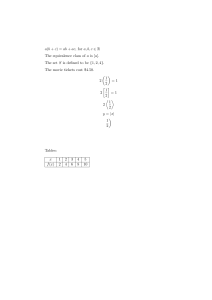

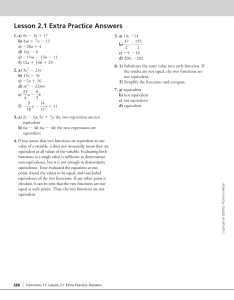
![MA1124 Assignment3 [due Monday 2 February, 2015]](http://s2.studylib.net/store/data/010730345_1-77978f6f6a108f3caa941354ea8099bb-300x300.png)
